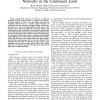Free Online Productivity Tools
i2Speak
i2Symbol
i2OCR
iTex2Img
iWeb2Print
iWeb2Shot
i2Type
iPdf2Split
iPdf2Merge
i2Bopomofo
i2Arabic
i2Style
i2Image
i2PDF
iLatex2Rtf
Sci2ools
TIT
2010
2010
Average message delivery time for small-world networks in the continuum limit
Small-world networks are networks in which the graphical diameter of the network is as small as the diameter of random graphs but whose nodes are highly clustered when compared with the ones in a random graph. Examples of small-world networks abound in sociology, biology, neuroscience and physics as well as in human-made networks such as the Internet, power grids and businesses. This paper analyzes the average delivery time of messages in dense small-world networks constructed on metric-measure spaces. Iterative equations for the average message delivery time in these networks are provided for the situation in which nodes employ a simple greedy geographic routing algorithm. It is shown that two network nodes communicate with each other only through their short-range contacts, and that the average message delivery time rises linearly if the separation between them is small. On the other hand, if their separation increases, the average message delivery time rapidly saturates to a constan...
| Added | 22 May 2011 |
| Updated | 22 May 2011 |
| Type | Journal |
| Year | 2010 |
| Where | TIT |
| Authors | Hazer Inaltekin, Mung Chiang, H. Vincent Poor |
Comments (0)

